-
Paper Information
- Next Paper
- Previous Paper
- Paper Submission
-
Journal Information
- About This Journal
- Editorial Board
- Current Issue
- Archive
- Author Guidelines
- Contact Us
International Journal of Agriculture and Forestry
p-ISSN: 2165-882X e-ISSN: 2165-8846
2014; 4(4): 293-299
doi:10.5923/j.ijaf.20140404.05
Effect of Planting Time and the Use of Fertilizer on Canola Yield and Yield Components
Mohsen Javaheri1, Amir Hossein Shiranirad2, Jahanfar Daneshian2, Ebrahim Amiri3, Saeed Saifzadeh1
1Department of Agronomy, College of Agriculture, Takestan Branch, Islamic Azad University, Takestan, Iran
2Seed and Plant Improvement Institute, Karaj, Iran
3Department of water Engineering, College of Agriculture, Lahijan Branch, Islamic Azad University, Lahijan, Iran
Correspondence to: Mohsen Javaheri, Department of Agronomy, College of Agriculture, Takestan Branch, Islamic Azad University, Takestan, Iran.
| Email: |  |
Copyright © 2014 Scientific & Academic Publishing. All Rights Reserved.
Determining suitable planting time plays an important role in conformation of plant growth stages with desirable environmental conditions which results maximum yield, therefore the experiment was conducted a factorial split plot arranged in randomized complete blocks design with four replications in two planting time (PT) at one year. Main plots consisted of two level of organic manure, (OM1) and (OM2) and five level of chemical fertilizer, (CF1), (CF2), (CF3), (CF4), (CF5) and sub plots consisted of two cultivar(C) (Okapi and Zarfam). Results of composed variance analysis showed that harvest index trait was significantly affected by planting time and chemical fertilizer, third level of chemical fertilizer application had highest harvest index with38.33 percent that caused to observed highest seed yield with 2492 (Kg/ha) from third level of chemical fertilizer application, so highest oil percent was observed from first planting time with 41.9 percent that showed importance of suitable planting time, in continuance results showed that carotenoid contentwas significantly affected by planting time and chemical fertilizer and highest carotenoid content was observed from third level of chemical fertilizer application so in comparison between organic manure treatments results showed that Okapi cultivar with 0.49 (mg/g) had highest carotenoid content.
Keywords: Keywords Canola, Fertilizer, Organic manure, Planting time
Cite this paper: Mohsen Javaheri, Amir Hossein Shiranirad, Jahanfar Daneshian, Ebrahim Amiri, Saeed Saifzadeh, Effect of Planting Time and the Use of Fertilizer on Canola Yield and Yield Components, International Journal of Agriculture and Forestry, Vol. 4 No. 4, 2014, pp. 293-299. doi: 10.5923/j.ijaf.20140404.05.
Article Outline
1. Introduction
- During the last decades the acreage of winter oilseed rape has been increased considerably in the world [31]. Planting time affects canola yield, seed oil and protein production and delayed sowing reduces total N concentration at 5-6 rosette stage by 50% in young mature leave petioles [11], so Farr et al[6] concluded that rate of yield decline per week attributed to delayed sowing have ranged from 3.2%to 8.6%. Oil concentration reduced by 3% per month sowing delay they concluded reduction was due to increased temperature and water stress during grain filling [11]. Marrison and stewart [26] observed that flowering of rape is inhibited above 27℃. Therefore, in the desert southwest, planting time may be important to avoid high temperatures at the end of the growing season.Fertilization is one of the soil and crop management practices, which exert a great influence on soil and grain quality [27]. Compared to cereals, canola requires a higher amount of nutrients. Proper use of fertilizer sources is required to optimize the economic yield and to minimize the potential for environmental pollution. Farmyard manure (FYM) and compost are organic sources of nutrients that also have been shown to increase soil organic matter and enhance grain quality. Introducing a good fertilization system can lead to increase grain yield and improve food quality [11]. Kudernatsch et al [20] reported that Climate change affected the length of the growing season and growth duration of plants, and subsequently the survival and reproduction of high elevation plants. Nitrogen is the most expensive fertilizer used to raise crop plants [29]. Majnoun Hosseini et al [23] reported that the interaction effects of plant density and nitrogen were also significant except for pods per plant and oil percentage and yield of plants. Nitrogen and sulphur are among the most important elements in oilseed crop production especially in canola [24].Jackson [15] found that the highest canola seed yields were achieved when 180 to 220 kg N ha-1 of nitrogen was applied. Canola nitrogen requirement is higher than cereals and it is considered as a high nitrogen demanding crop [29]. So Butkut et al [3] concluded that Rapeseed oil, compared with other kinds of oil, contains low levels of saturated fatty acids, a high percentage of oleic acid and an optimal ratio of polyunsaturated fatty acids for both nutrition and feeding needs. Thus the objectives of this research were to evaluated effect of planting time and the use of organic and chemical fertilizer on canola yield and yield components.
2. Materials and Methods
2.1. Site Description
- The field assay was conducted in 2013 growing season at the Agricultural Research Center of Sanandaj, Iran that located at (36˚ 11′ N latitude and 46˚ 19′ E longitude) with an altitude of 1393 m above sea during 2012-2013. This region has a semi-arid climate (340 mm annual rainfall). The soil texture of the experimental site is a clay loam, with a pH of 7.9 and Ec=.046 (EC*104) (using an Electrical Conductivity Meter) (Table 1).
|
2.2. Experimental Design
- A field experiment was carried out a factorial split plot arranged in randomized complete blocks design with four replications in two planting time (PT) at one year with regarded management of time and quantity Main plots consisted of two level of organic manure, non application( OM1) (control) and application (OM2) and five level of chemical fertilizer that fertilizer split to three section in each treatment (CF1) consisted of non application in planting time, application in shoot appearance stage and beginning of flowering stage(with recommended measure), (CF2) consisted of application in planting time, shoot appearance stage and beginning of flowering stage (with recommended measure), (CF3) consisted of application in double leaf stage, shoot appearance stage and beginning of flowering stage(with recommended measure), (CF4) consisted of application in planting time(with recommended measure), application in shoot appearance stage and beginning of flowering stage (with increased 25 percent), (CF5) consisted of application in double leaf stage (with recommended measure), application in shoot appearance stage and beginning of flowering stage(with increased 25 percent), and sub plots consisted of two cultivar (Okapi and Zarfam), Each sub plot was 7.5 m long and consisted of 6 rows, 30 cm apart with intra row spacing of 5 cm to achieve the plant density of 66 plants/m2, land of experiment was plowed in autumn of previous year and in spring of experiment year was disked , With attention to annual rainfall mean, soil test and farmyard manure analysis results (Table 1,2) application of chemical, organic manure and phosphorus with attention to of physiochemical test soil was about 150 kg/ha for chemical manure (Urea), 20t/ha for organic manure (farmyard manure) and 140 kg/ha for phosphorus. Evaluated traits consist of Pod number in main stem, Pod number in secondary stem, pod length in main stem, pod length in secondary stem, Harvest index, Seed yield, Oil percent, carotenoid content. The estimation of oil percent was extracted with petroleum ether using Soxhlet [1].
|
2.3. Sampling
- At maturity stage, 12 plants from each plot were randomly selected for the measurement of yield components. Harvested area was 7.5m × 1.8m in each plot. Seed yield of canola was adjusted to 10% moisture content.
2.4. Statistical Analysis
- The experimental data were statistically analyzed by (ANOVA) using MSTAT-C, Version 1.41, Crop and Sciences Department, Michigan State University, and Duncan's multiple range in (P ≤ 0.05) used to compare means of traits.
3. Results and Discussion
3.1. Pod Number in Main Stem
- Results of composed variance analysis showed that pod number in main stem was significantly affected by planting time, chemical fertilizer and organic manure treatments (Table 3) and means comparison with Duncan's multiple range in (P ≤ 0.05) showed that highest Pod number in main stem with 28 number was observed from application of third level of chemical fertilizer, this positive effect was attributed to importance of application time of chemical nitrogen fertilizer (Table 4). During the period of grain formation in other research result showed that nitrogen had importance role in plants growth [20]. Nitrogen in plants had important role and in addition chemical fertilizer and interaction among planting time × chemical fertilizer × organic manure had significant effect on pod number in main stem (Table 3), fourth level of chemical fertilizer (F4) had lowest pod number in main stem, in comparison between cultivars Okapi with 22 (number) had highest Pod number in main stem so interaction between application of organic manure and third level of chemical fertilizer, had highest pod number in main stem that showed importance of application organic manure and chemical fertilizer in double leaf stage. Hokmalipou et all [13] reported that pod number of the stem was significantly affected by genotypes and interaction between the sowing date and genotypes. pod number of fertile genotypes of canola, was affected by weather conditions [25].
3.2. Pod Number in Secondary Stem
- Regarding pod number in secondary stem result showed that organic manure had significant effect in (p<1%), pod number in secondary stem and highest pod number in secondary stem was observed from first planting time with 51(number) and lowest pod number in secondary stem was observed from second planting time. So organic manure, chemical fertilizer, cultivar treatments had significant effects on pod number in secondary stem (Table 3) this positive effects were attributed to increasing pod seed, in mean comparison Okapi had highest pod number in secondary stem (Table 4). So interaction among planting time × chemical fertilizer × organic manure had significant effect on pod number in secondary stem. Degenhardt and Kondra [4] reported that with delay in sowing date pod number per plant decreases. Nitrogen is one of the most important elements that plays a key role in plant growth and yield so protein synthesis, protoplasm, cell size, and photosynthetic activity and thus provides huge pods [37].
3.3. Pod Length in Main Stem
- Results of composed variance analysis showed that pod length in main stem was significantly affected by organic manure(Table 3) so means comparison with Duncan's multiple range in (P ≤ 0.05 ) showed that highest pod length in main stem was observed from first planting time (Table 4) thus pod length in main stem in plants have been affected from organic manure, so results showed that interaction between planting time × chemical fertilizer × organic manure had significant effects on, pod length in main stem, Okapi cultivar with 7 percent had highest pod length in main stem and in comparison between chemical fertilizer levels showed that third level of chemical fertilizer treatment had highest pod length in main stem.
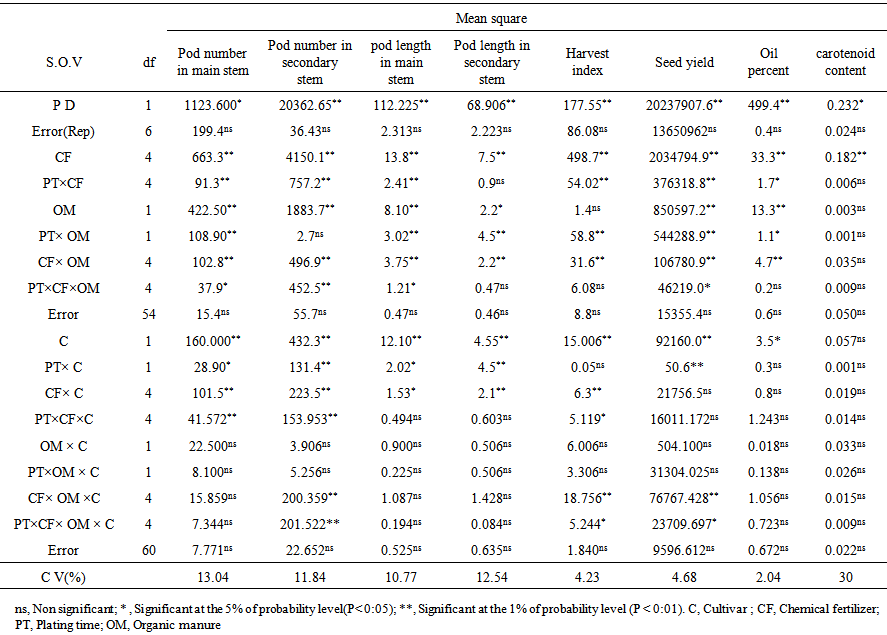 | Table 3. Results of variance analysis traits under treatments effects |
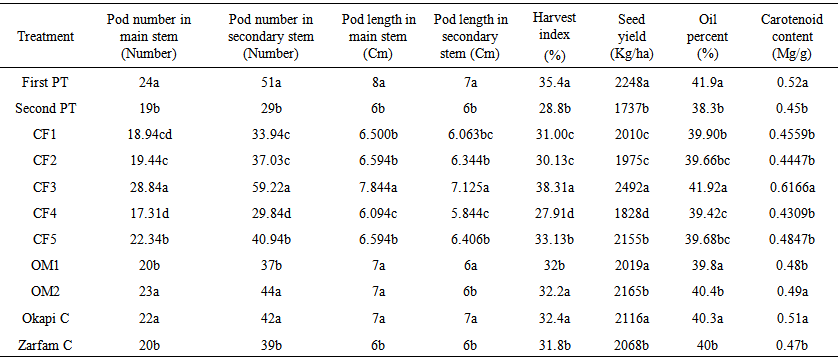 | Table 4. Mean values of traits as influenced by treatments |
3.4. Pod Length in Secondary Stem
- Results of composed variance analysis showed that pod length in secondary stem was significantly affected by planting time, organic manure, chemical fertilizer and cultivar (Table 3), so highest pod length in secondary stem was observed from third level of chemical fertilizer with 7 (Cm) per plant and comparison between organic manure treatment showed that all level stand in statistical equal group (Table 4) Nitrogen (N) fertilizer increases yield by influencing a variety of growth parameters such as the number of branches per plant, the number of pods per plant, the total plant weight, the leaf area index. Interaction between planting time and organic manure so between organic manure and chemical fertilizer had significant effects on pod length in secondary stem, in comparison between cultivars Okapi with 7 (Cm) had highest pod length in secondary stem. Khan et all [18] also concluded that positive significant correlation between seed yield and plant height, pods per plant, seeds per pod and pod length.
3.5. Harvest Index
- Harvest index trait was significantly affected by planting time, chemical fertilizer (Table 3) and means comparison of with Duncan's multiple range in (P ≤ 0.05) showed that third level of chemical fertilizer application had highest harvest index with38.33 percent and lowest harvest index was observed from forth level of chemical fertilizer application with 27.9 percent (Figure 1). Taschler et all [34] concluded N fertilizer had significant influence on seed yield, biological yield and oil yield. It had no significant influence on the number of seed per pod, a thousand seed yield, oil percentage and harvest index. Interaction between treatments showed that planting time and organic manure so chemical fertilizer and organic manure had significant effects on harvest index, cultivar and interaction between chemical fertilizer and cultivar had significant effects on harvest index. Keivanrads et all [17] reported that the effect of N fertilizer was significant on seed per pod, a thousand seed weight, seed yield, biological yield, oil percentage, oil yield. In comparison between cultivars Okapi cultivar had highest harvest index with 32.4 percent (Table 4). Cultivar had significant influence on seed yield, thousand seed weight, oil percentage, oil yield, biological yield and harvest index [32].Keivanrads et all [17] reported that the effect of N fertilizer was significant on biological yield and harvest index. In comparison between cultivars Okapi cultivar had highest harvest index with 32.4 percent (Table 4). Cultivar had significant influence on seed yield, thousand seed weight, oil percentage, oil yield, biological yield and harvest index [32].
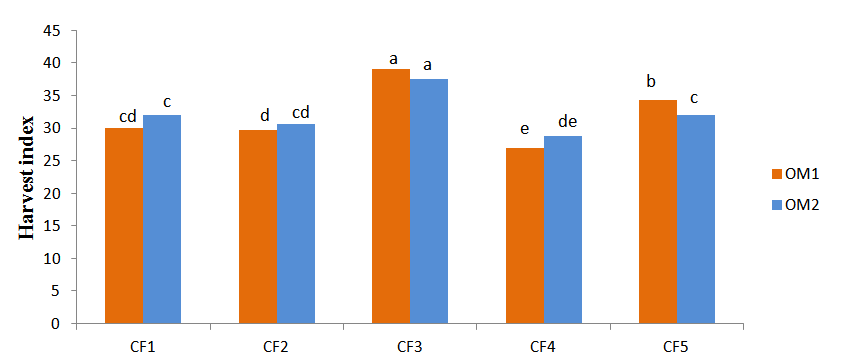 | Figure 1. Interaction effects of organic manure and chemical fertilizer on harvest index |
3.6. Seed Yield
- Planting time, organic manure and chemical fertilizer had significant effects on Seed yield in (p<1%), (Table 3) and means comparison with Duncan's multiple range in(P ≤ 0.05 ) showed that third level of chemical fertilizer had highest seed yield with 2492 kg/ha so 2248 and 2165 kg/ha were observed from first planting time and application of organic manure respectively, that showed importance of suitable planting time and application of organic manure (Figure 2), Jansinka et all [16] concluded that with delay in sowing date seed yield decreased that similar to findings of Taylor and smith [35] observed that seed yield declined when sowing date is delayed, in comparison between planting times result showed that first planting time had highest seed yield that showed importance of suitable planting time, result showed that interaction between planting time and organic manure and planting time and chemical fertilizer so interaction among planting time×chemical fertilizer×organic manure × cultivar had significant effect on seed yield and Okapi cultivar had highest seed yield (Table 4). Fathi [7] observed that increasing nitrogen fertilizer and plant density caused a boost in seed yield in canola and the highest yield per hectare resulted from 225 kg N ha-1, so result of one research showed that the highest canola seed yield were achieved when 180 to 220 kg N ha-1 of nitrogen was applied. Absorption of other nutrients is also strongly related to sufficient nitrogen [15].
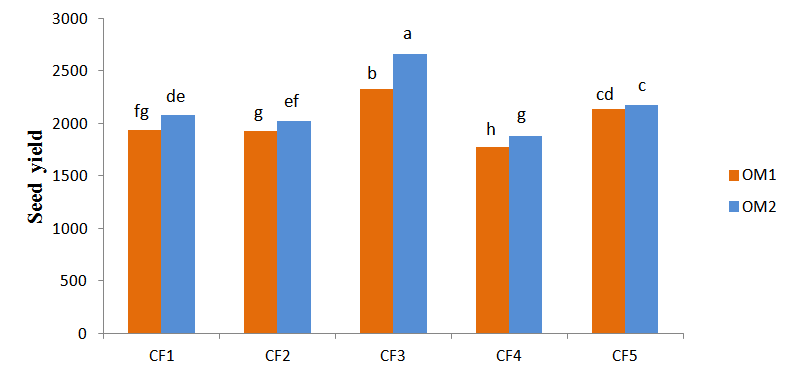 | Figure 2. Interaction effects of organic manure and chemical fertilizer on seed yield |
3.7. Oil Percent
- Oil percent was significantly affected by planting time, chemical fertilizer and organic manure (Table 3).Thus result of means comparison with Duncan's multiple range in (P ≤ 0.05) showed that highest oil percent was observed from first planting time with 41.9 percent and second planting time with 38.3 had lowest oil percent (Table 4), that showed importance of suitable planting time that similar to findings of Mackinnon and fettell [22] reported that with delaying in planting time grain yield was decreased so delayed planting time had significant reduction on grain yield and oil grain. Jakson [15] reported that application of N at 120 kg/ha (N2) gave the maximum oil content. Cultivars had significant effect on oil percent and interaction between planting time ×organic manure and chemical fertilizer × organic manure had significant effects on oil percent. Okapi cultivar had highest oil percent with 40.3 percent (Figure 3).Different letters within each group of a column indicate significant differences at P ≤ 0.05 according to Duncan's multiple range test. C, cultivar; CF1, First level of chemical fertilizer; CF2, Second level of chemical fertilizer; CF3, Third level of chemical fertilizer; CF4, Fourth level of chemical fertilizer; CF5, Fifth level of chemical fertilizer; OM1, Non application of organic manure; OM2, Application of organic manure; PT, Planting time.
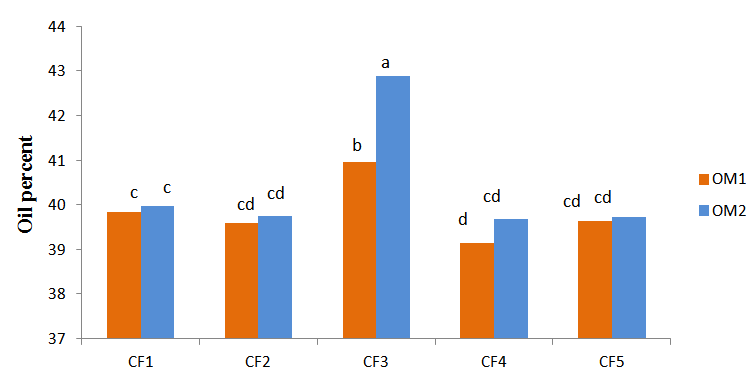 | Figure 3. Interaction effects of organic manure and chemical fertilizer on oil percent |
3.8. Carotenoid Content
- Results of composed variance analysis showed that carotenoid content was significantly affected by planting time and chemical fertilizer (Table 3) Carotenoids, which include carotenes and their oxygen containing derivatives - xanthophylls, play many important biological functions in plants. In chloroplasts they act as accessory pigments in light-harvesting complexes and transfer energy to chlorophylls [30], so means comparison with Duncan's multiple range in (P ≤ 0.05) showed that highest carotenoid content was observed from third level of chemical fertilizer application (table 4). So in comparison between organic manure treatments results showed that Okapi cultivar with 0.49 (mg/g) had highest carotenoid content.
4. Conclusions
- Our results showed that organic nitrogen source had significant effect on growth, yield and oil percent of canola and yield of plants was increased with application of nitrogen fertilizer in double leaf stage, shoot appearance stage and flowering stage with recommended scale.
ACKNOWLEDGEMENTS
- We are grateful for grants from Faculty Research of Takestan Branch, Islamic Azad University, Takestan Iran, Agricultural Research Center of Sanandaj, Iran and Seed and Plant Improvement Institute, Karaj, Iran.
Abbreviations
- C, cultivar; CF1, First level of chemical fertilizer; CF2, Second level of chemical fertilizer; CF3, hird level of chemical fertilizer; CF4, Fourth level of chemical fertilizer; CF5, Fifth level of chemical fertilizer; OM1, Non application of organic manure; OM2, Application of organic manure; PT, Planting time.
 Abstract
Abstract Reference
Reference Full-Text PDF
Full-Text PDF Full-text HTML
Full-text HTML
